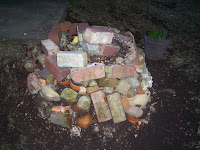 |
| Maya and the herb spiral last year right after I built it. |
So today I worked on cleaning up the herb spiral I built last year. It was an idea I found online and knew was perfect. I had been using a corner off our little concrete patio as an herb garden and this location totally lent itself to the spiral shape. An herb spiral has a bunch of benefits. 1. it creates micro-climates so you can grow herbs that have different growing needs in the same space. 2. It allows you to fit more herbs in a small location since you are "building up, not out" 3. It is attractive and unique. 4 The how to is pretty easy, I did it in one afternoon. 5 the cost is practically nothing
 |
| Chives that have overwintered |
 |
| The herb spiral two weeks ago. |
The concept of an herb spiral is that you build, with rocks and soil, a spiral (Conch shell) shape. The topmost area is not shaded and rain drains down, so it is the warmest and driest area, the middle level is not as sunny or dry, and the bottom is the most shaded and wettest area(you can even make a pond or bog at the bottom!).
You then plant your herbs accordingly, to what "climate" best suits their needs and voila! I used rocks and bricks and pieces of broken terracotta that I had around the yard (free). This year I will have to supplement the soil given the dreaded walnuts, but you can use your own soil if it is not poison (free in most cases) you just have to jazz it up a bit with some gravel and sand and some compost. (free or nearly so in most cases). I plan on getting some more sand and adding some topsoil and and some manure to add to the spiral, (it has settled a lot since last year, so I would have had to add to it no matter what). So far it has Thyme and Sage sprouting and then the Chives that I keep in the pot at the bottom. I may try a pond or bog later but for now the chives enjoy the bottom spot.
 |
| Clean and waiting for more soil and eventually plants |





No comments:
Post a Comment